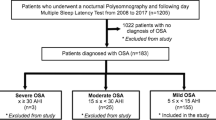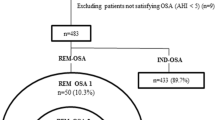Abstract
Sleep fragmentation from obstructive sleep apnea (OSA) is correlated with a shortened sleep latency on the Maintenance of Wakefulness Test (MWT) and the Multiple Sleep Latency Test. Whether impairment of wakefulness is associated with increased mortality in OSA patients is unknown. We evaluated survival over an average timespan of 7.5 years from the date of diagnosis in a consecutive series of 322 OSA patients who had undergone nocturnal polysomnograpy and the MWT. Evaluable survival data were obtained in 142 patients. Twenty two had died. Deaths were predominantly due to cardiovascular disease. A comparison of the demographic and sleep study data between the alive and dead groups was significant for differences in MWT sleep latency and in age at time of diagnosis. The MWT mean sleep latency, when adjusted for age, was significantly shortened in the dead patients (28 ± 11 min vs. 21 ± 10 min, p < 0.005). Also, there was a significant decrease in survival in the patients whose MWT mean sleep latency was less than 20 min. These findings demonstrate an association between impairment of wakefulness and long-term mortality in OSA patients. This association was not evident for the other measures used to assess OSA severity.
Similar content being viewed by others
References
Poceta JS, Timms RM, Jeong DU, Ho SL, Erman MK, Mitler MM. Maintenance of wakefulness test in obstructive sleep apnea syndrome. Chest 1992;101:893–897
Roehrs T, Zorick F, Wittig R, Conway W, Roth T. Predictors of objective level of daytime sleepiness in patients with sleep-related breathing disorders. Chest 1989;95:1202–1206
Findley LJ, Levinson MP, Bonnie RJ. Driving performance and automobile accidents in patients with sleep apnea. Clin Chest Med 1992;13:427–435
Partinen M, Jamieson A, Guilleminault C. Long-term outcome for obstructive sleep apnea syndrome patients. Mortality [see comments]. Chest 1988;94:1200–1204
He J, Kryger MH, Zorick FJ, Conway W, Roth T. Mortality and apnea index in obstructive sleep apnea. Experience in 385 male patients. Chest 1988;94:9–14
Lavie P, Herer P, Peled R, Berger I, Yoffe N, Zomer J, Rubin AE. Mortality in sleep apnea patients: A multivariate analysis of risk factors. Sleep 1995;18:149–157
Gonzalez-Roth RJ, Foresman GE, Block AJ. Do patients with sleep apnea die in their sleep? Chest 1988;94:531–538
Block AJ. Mortality and sleep apnea: The trouble with looking backward. Chest 1988;94:679–680
Partinen M, Guilleminault C. Daytime sleepiness and vascular morbidity at seven-year follow-up in obstructive sleep apnea patients. Chest 1990;97:27–32
MacLean AW, Criollo M, Fekken GC, Knowles JB. the Stanford Sleepiness Scale in a clinic sample: The need for revision. Sleep Res 1991;1:250
Poceta JS, Hajdukovic R, Timms RM, Erman MK, Mitler MM. The Scripps Clinic Sleep Apnea Profile-a severity grading scale. Sleep Res 1993;22:250
Mitler MM, Gujavarty KS, Browman CP. Maintenance of wake-fulness test: Evaluation of treatment efficacy for disorders of excessive sleepiness. Sleep Res 1982;11:159
Rechtschaffen A, Kales A. A manual of standardized terminology, techniques and scoring system for sleep stages of human subjects. Bethesda, MD: Natl Inst Neurol Dis Blind (NIH Publ. 204); 1968
Hoddes EV, Zarcone V, Smythe H, Phillips R, Dement WC. Quantification of sleepiness: A new approach. Psychophysiology 1973;10:431–436
Mantel N. Evaluation of survival data and two new rank order statistics arising in its consideration. Cancer Chemother Rep 1966;50:163–170
Loube DI, Loube AA, Mitler MM. Weight loss for obstructive sleep apnea: The optimal therapy for obese patients. J Am Dietetic Assoc 1994;94:1291–1295
Batschelet E. Circular statistics in biology. New York, Academic Press, 1981
Lin B, Orr WC, Adamson P, Vanoli E, Imes NK. Sympathetic and vagal modulation of cardiac activity during sleep in obstructive sleep apnea syndrome. Sleep Res 1994;23:282
Fletcher EC. The relationship between systemic hypertension and obstructive sleep apnea: Facts and theory. Am J Med 1995;
Levy PA, Guilleminault C, Fagret D, Gaio JM, Romand P, Bonnet C, Pison CM, Wolf JE, Paramelle B. Changes in left ventricular ejection fraction during REM sleep and exercise in chronic obstructive pulmonary disease and sleep apnoea syndrome. Eur Respir J 1991;4:347–352
Rieke K, Poceta JS, Mitler MM, Ley LR, Torruella AK, Adams H-P, Otis SM. Continuous blood flow velocity measurements in obstructive sleep apnea syndrome. J Neuroimag 1992;2:202–207
Shepard JW Jr, Garrison MW, Grither DA, Dolan GF. Relationship of ventricular ectopy to oxyhemoglobin desaturation in patients with obstructive sleep apnea. Chest 1985;88:335–340
Philip P, Guilleminault C. ST segment abnormality, angina during sleep and obstructive sleep apnea [letter]. Sleep 1993;16: 558–559
Balfors EM, Franklin KA. Impairment of cerebral perfusion during obstructive sleep apneas. Am J Respir Crit Care Med 1994;150:1587–1591
Bliwise DL, King AC, Harris RB. Habitual sleep durations and health in a 50–65 year old population. J Clin Epidemiol 1994;47:35–41
Hanly P, Zuberi-Khokhar N. Daytime sleepiness in patients with congestive heart failure and Cheyne–-Stokes respiration. Chest 1995;107:952–958
Ancoli-Israel S, Engler RL, Friedman PJ, Klauber MR, Ross PA, Kripke DF. Comparison of patients with central sleep apnea. With and without Cheyne–-Stokes respiration. Chest 1994;106:780–786
Smith PL, Meyers DA, Haponik EF, Bleeker ER. Objective assessment of severity of sleep disorded breathing: Relationship to clinical manifestations. Am Rev Respir Dis 1994;149:56
Johns MW. Daytime sleepiness, snoring, and obstructive sleep apnea. The Epworth Sleepiness Scale. Chest 1993;103:30–36
Thorpy MJ. Report from the American Sleep Disorders Association. The clinical use of the Multiple Sleep Latency Test. Sleep 1992;15:268–276
Mitler MM. Daytime sleepiness and cognitive functioning in sleep apnea. Sleep 1993;16:S68–70
Sangal RB, Thomas L, Mitler MM. Disorders of excessive sleepiness. Treatment improves ability to stay awake but does not reduce sleepiness. Chest 1992;102:699–703
Author information
Authors and Affiliations
Additional information
Supported by NIH grants NS30019, MH47680 to Dr. Mitler and Clinical Research Center grant AA08235 to the Scripps Research Institute.
Rights and permissions
About this article
Cite this article
Poceta, J.S., Loube, D.I., Kellgren, E.L. et al. Mortality in Obstructive Sleep Apnea: Association with Impaired Wakefulness. Sleep Breath 3, 3–8 (1999). https://doi.org/10.1007/s11325-999-0003-x
Issue Date:
DOI: https://doi.org/10.1007/s11325-999-0003-x




